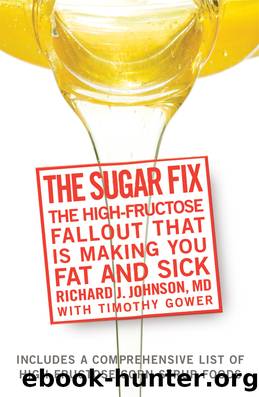The Sugar Fix by Richard Johnson

Author:Richard Johnson
Language: eng
Format: epub
Publisher: Harmony/Rodale
Published: 2012-08-15T00:00:00+00:00
Fruit
Fruit poses a dilemma. On the one hand, biting into a crisp apple or a juicy orange slice makes us feel virtuous for a reason. Fruit is full of vitamins and minerals, as well as micronutrients called phytochemicals, which growing scientific evidence suggests can fight disease and aging. Fruit is also an excellent source of fiber. Yet the sweetness that makes apples and oranges so delicious has a bitter edge, because every bite of fruit provides a potent dose of fructoseâbetween 5 and 10 grams per serving, in most cases.
This makes fruit a good news/bad news food group. The large amounts of fructose in fruit activate the unhealthy metabolic pathways Iâve described in preceding chapters, ultimately causing cells to absorb too much fat and become insulin resistant. On the other hand, the nutrients in fruitâespecially vitamin C and potassiumâblock many of these same pathways.
Because of these opposing influences, a slender, active person may be able to eat fruit without worry. But if you are currently overweight and sedentary, your fructose enzymesâwhich produce this simple sugarâs dangerous effectsâare probably raging out of control. If thatâs the case, any benefits from vitamin C and other nutrients will be trumped by the overwhelming damage that fructose will cause.
You probably never dreamed that a physician would tell you to stop eating fruit, but thatâs exactly what Iâm advisingâbut only for 2 weeks. During the initial 14-day phase of the Low-Fructose Diet, you will dramatically reduce your fructose intake in order to rein in your fructose enzymes. Abstaining from fruit and other sources of fructose for a brief period will help bring your levels of these enzymes back down to normal and turn off the mechanisms that inflict so much harm. (By the way, this directive also applies to fruit juice, which contains even higher concentrations of fructose than the fruit itself.)
Donât worryâgoing a couple of weeks without eating fruit is not a threat to your long-term health. To the contrary, this short break from consuming fructose will help to correct metabolic problems that may build up flab, raise your blood pressure, and create other unhealthy symptoms. Besides, unlike low-carbohydrate diets, my plan allows you to eat a variety of vegetables, even during the 2-week introduction, so you will still be consuming natural sources of vitamins, minerals, and phytochemicals.
Once you have completed the first phase of the diet, you are free to enjoy fruit and its considerable health benefits once again, but only in moderation and always ensuring that your total fructose intake does not exceed the generous range of 25 to 35 grams per day. Bear in mind that fruit varies greatly in its fructose content. A single plum has just 2 grams of fructose, for example, while a cup of watermelon contains 24 grams, or nearly 1 dayâs worth.
Eating a variety of fruits is a great idea, as long as they fit into your daily fructose budget. Those with high concentrations of vitamin C may be the best choices, given how effectively this antioxidant nutrient helps to control certain conditions of metabolic syndrome.
Download
This site does not store any files on its server. We only index and link to content provided by other sites. Please contact the content providers to delete copyright contents if any and email us, we'll remove relevant links or contents immediately.
Zero to IPO: Over $1 Trillion of Actionable Advice from the World's Most Successful Entrepreneurs by Frederic Kerrest(4395)
Machine Learning at Scale with H2O by Gregory Keys | David Whiting(4256)
Never by Ken Follett(3874)
Harry Potter and the Goblet Of Fire by J.K. Rowling(3800)
Ogilvy on Advertising by David Ogilvy(3546)
Shadow of Night by Deborah Harkness(3322)
The Man Who Died Twice by Richard Osman(3035)
Book of Life by Deborah Harkness(2889)
Will by Will Smith(2863)
The Tipping Point by Malcolm Gladwell(2860)
0041152001443424520 .pdf by Unknown(2810)
My Brilliant Friend by Elena Ferrante(2788)
How Proust Can Change Your Life by Alain De Botton(2767)
Purple Hibiscus by Chimamanda Ngozi Adichie(2725)
How to Pay Zero Taxes, 2018 by Jeff A. Schnepper(2621)
Hooked: A Dark, Contemporary Romance (Never After Series) by Emily McIntire(2526)
Rationality by Steven Pinker(2321)
Borders by unknow(2277)
Can't Hurt Me: Master Your Mind and Defy the Odds - Clean Edition by David Goggins(2266)
